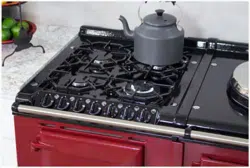Loading ...
Loading ...
Loading ...

15
REMEMBER: BE CAREFUL OF THE HOT
APPLIANCE.
DO NOT USE A STEAM CLEANER TO CLEAN
THIS RANGE.
DO NOT USE ABRASIVE PADS, CAUSTIC
CLEANERS, OVEN CLEANERS OR METAL
SCRAPERS TO CLEAN THE SURFACES OF
THE ENAMEL.
FOR MOST CLEANING IT IS BEST WHEN THE
APPLIANCE IS TURNED OFF.
DO NOT IMMERSE THE DOORS IN WATER AS
THEY ARE PACKED WITH INSULATING
MATERIAL, WHICH WILL BE DAMAGED BY
EXCESSIVE MOISTURE.
DO NOT PUT OVEN DOORS IN A
DISHWASHER. THE FOLLOWING LOOSE
PARTS MUST NOT BE CLEANED IN A
DISHWASHER, AS THIS COULD DAMAGE OR
DISCOLOUR THE FINISH, PAN SUPPORTS,
BURNER CAPS, BURNER RING AND BURNER
HEAD.
Caring and cleaning
Enamelled cast iron
Top plate, front plate and oven doors -
The easiest
way to clean the enamelled cast iron parts is to mop up
spills as soon as they happen. It maybe useful to keep a
damp cloth handy to do this. Baked on food is more
difficult to clean but can usually be removed with the
AGA vitreous enamel cleaner or mild cream cleaners
using a damp cloth, or, if necessary a nylon scouring
pad. If milk or fruit juice or anything containing acid, is
spilt on the range, wipe it up immediately. Clean off any
condensation streaks on the front plate around the oven
doors or the vitreous enamel maybe permanently
discolored.
To keep the vitreous enamel surfaces of the range bright
and clean, a daily rub over with a damp soapy cloth
followed immediately with a clean, dry cloth to avoid
streaks is all that is required. AGA E-cloths are excellent
for this.
Enamelled cookware
Enamelled roasting pans - supplied with the AGA
TC/DC Module should be cleaned in hot soapy water,
soaking if necessary. A nylon scouring pad can also be
used. They may also be cleaned in the dishwasher, but
with constant use, the enamelled finish will become dull
in appearance.
Gas Top Burners
If spillage does occur on a burner cap or pan support,
move pan to another burner and when cool, clean in hot
soapy water. After cleaning, be sure all parts are dry.
When fitting the burner cap and burner head make that
the hole in the burner head is correctly located over the
ignition electrode. (See Figs. 3a, 3b and 3C) and that
the burner cap is sitting correctly on the burner head.
The ignition electrode must not be displaced or
damaged otherwise spark ignition will be affected. The
hotplate top is sealed. To clean, remove pan supports
and wipe over visible surface.
PLEASE NOTE: Alumimium pans may cause metallic
marking on the pan supports. This will not affect the
durability of the enamel.
NOTE: The appliance guarantee does not cover the
mis-use of the pan supports.
Ovens
The ovens are fitted with side and back panels and are
of self cleaning enamel and should not be scoured.
The shelves can be removed, if necessary the shelf
supports can also be removed by removing the screws.
These items may be washed in the sink with normal
oven cleaners, a fine wool soap pad for removing
stubborn stains from the oven bases and shelf supports.
NOTE: TAKE CARE NOT TO DAMAGE THE OVEN
THERMOSTAT SENSOR IN THE OVENS WHEN
CLEANING.
Heat-Clean Enamel
Fan Oven, Conventional Oven, Simmering Oven: sides,
top and back
Grill Compartment: sides and back
This special enamel has a continuous cleaning action,
which works best if a pattern of low and high temperature
cooking is followed. By using low temperature roasting,
excessive fat splashes can be avoided. Should any
excessive staining occur, immediately clean the area with
hot water containing detergent, and a nylon washing-up
brush. Resistant stains require the oven to be run at
410°F (210°C) for 2 hours.
Do not use any cleaning material which may clog
the pores of the special coating e.g. pastes and
powders, soap-filled pads, wire wool, spray
cleaners, brush-on cleaners, caustic solutions, metal
scrapers/knives, and prevent the continuous
cleaning action.
Door Liners
Using oven gloves carefully lift off the oven doors and
lay them on a tea towel. They can be cleaned with a
cream cleanser or soap impregnated pad.
Controls
The enamelled surfaces under the knobs can be treated
as in the section ‘Door Liners’. Avoid the use of
excessive water. DO NOT use oven cleaners, scouring
pads and abrasive powder for cleaning plastic knobs. A
wipe with a damp cloth should be sufficient.
Loading ...
Loading ...
Loading ...
